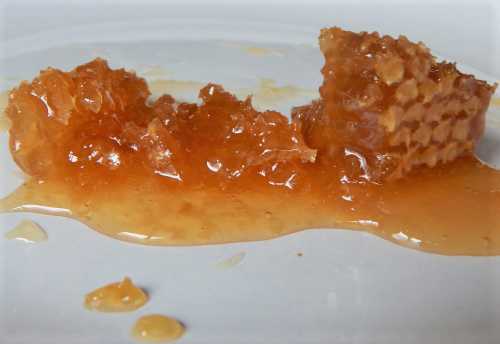The Honey Bee Queen
Updated: 5th May 2023
Honey bees are fascinating insects, and each bee within the colony plays an important role. The honey bee queen has her own amazing role to play - learn more about her by reading these fascinating facts.
5 Quick Facts About The Honey Bee Queen
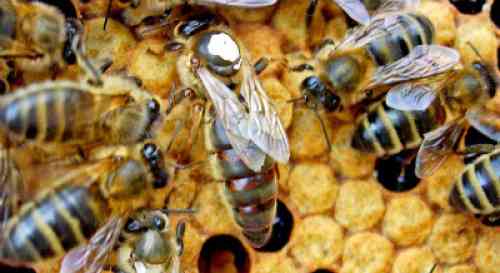 The honey bee queen with workers.
The honey bee queen with workers.- In a colony of 50,000 bees, there will be 1 queen,
and perhaps around 300 drones (males) and the rest will be female worker
honey bees. At exceptional times, there may temporarily be 2 queens, but not for very long.
- For the human eye, despite being larger than the workers, honey bee queens are difficult to spot among thousands and thousands of worker bees. For this reason, beekeepers mark queens with a dot of special bee paint on the thorax, as can be seen in the photograph above.
- If the honey bee queen is removed from a hive, within 15 minutes, all of the bees will know about it, and will frantically begin the task of creating a replacement!
Read more Honey Bee Facts. - As she establishes her colony, she may lay 2000 to 3000 eggs per day1 – more than her own body weight in eggs!
- If a queen is not performing very well (for example, if she is not laying enough eggs), the colony may decide to replace her with a new queen. This is called supersedure.
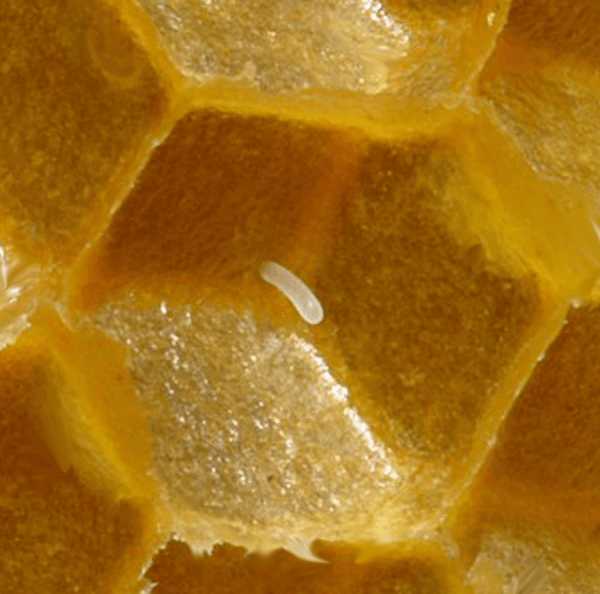 A single egg in a wax cell, laid by a queen
A single egg in a wax cell, laid by a queenHow Are Queen Honey Bees Different From Workers?
The honey bee queen is the largest of the bees in a honey bee (Apis) colony, measuring around 2 cm - that's about twice the length of a worker. Drones (males) are slightly larger than workers.
Can you spot the unmarked queen in the photograph below?
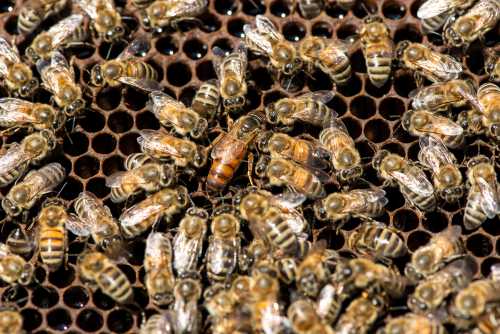
Apart from being significantly larger than workers, the roles that queens perform is very different from that of other members of the colony.
5 key activities of the queen honey bee:
- Mate with drone bees (males);
- Produce eggs;
- Give off pheromones that influence the behaviour and communicate with the rest of the colony;
- Help form new colonies through swarming.
This is in contrast to the role of workers. In an active colony of honey bees, workers perform most of the work required to maintain and sustain the colony.
These include: foraging for food; building honey comb; feeding the larvae, keeping the nest clean, and defending the nest from predators, such as wasps and hornets.
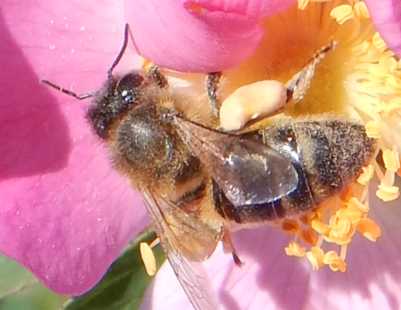 Worker honey bee foraging on rose.
Worker honey bee foraging on rose.From time to time, workers may also lay eggs, but these are usually destroyed by fellow workers.
The main role of drones is to mate with honey bee queens and thus ensure future generations of honey bees. They also help to control the temperature in the hive or nest2.
How Do Honey Bees Become Queens?
Despite the difference between herself and the female workers,
what may surprise many is that she is produced from eggs that are in
every way identical to those eggs producing workers.
The difference, however, is that larvae of potential queens are fed only a special substance called ‘royal jelly’. which they eat throughout there lives, from larva to adult.
Adult drones and worker larvae are fed on 'drone' or 'worker' jelly for 3 - 4 days, and after this, workers are fed on a slightly different jelly containing less protein3.
Also, see: How Do Honey Bees Get A New Queen?
Mating Behaviours
About a week after a new queen
emerges from her cell, she will take several flights in order to mate.
She may mate with as many as 20 drones, all while in the air! (The
drones, unfortunately, die after mating).
However, when the honey bee queen returns to lay her eggs, she will only rarely leave the colony after that.
Inside her, she will have enough sperm (which she stores in her sperm pouch – or spermatheca), so that she may continue to fertilise her eggs for the rest of her life.
When
she returns to the colony from her nuptial flight, and now impregnated,
the workers begin fussing over her.
They feed her so that her abdomen
swells, and lick her – a process which transfers a chemical (pheromone),
used to regulate the colony.
Here's a short video of the mating flight and queen laying eggs:
The Queen Pheromone And Communication
Pheromones are produced by the drones and workers, as well as the queen, who produces a ‘queen pheromone’.
The queen pheromone encourages workers to tend to her and the brood, whilst at the same time, inhibits the production of more queens.
So efficient is the pheromone for
communicating within the colony, that if the queen is removed from a
hive, within 15 minutes, all of the bees will know about it, and will
frantically begin the task of creating a replacement!
When colonies become very large so that workers cannot (due to the distance between themselves and the queen), detect the queen pheromone, then this encourages part of the colony to create a new queen.
A new
colony will then be formed.
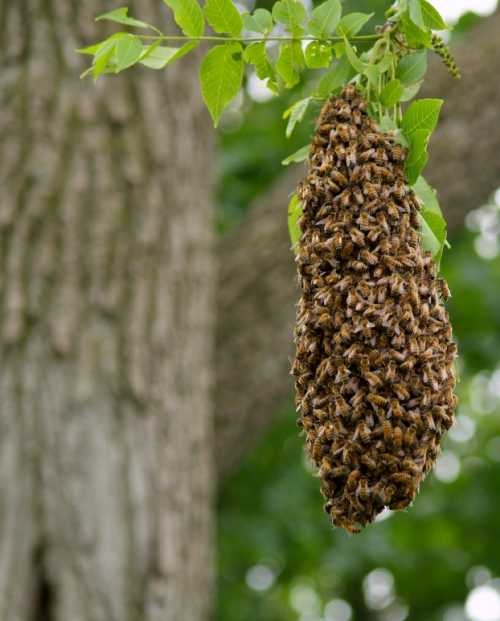 A swarm of honey bees.
A swarm of honey bees.This initiates 'bee swarming'. A clump of workers surrounding a queen honey bee might be seen resting temporarily on a tree branch or post whilst 'scout bees' are looking for a suitable place for a permanent nest.
However, it is the ‘old queen’ that will leave to find a suitable new nest, rather than the new one!
Honey bee queens live much longer than workers and drones. (You can learn more about this by reading about the honey bee life cycle).
If the queen performs well in the colony, she will probably live two or three years, but possibly as many as four or five - or even longer.
However, if she produces too few eggs, she may be replaced by a new queen - as stated above, this is know as 'supersedure'.
The new queen will be pampered with food and affection, whilst the old queen is left to waste away.
>
References:
(1) Fratini et al: Royal Jelly: An ancient remedy with remarkable antibacterial properties; Microbiological Research Volume 192, November 2016, Pages 130-141.
(2) Kovac H, Stabentheiner A, Brodschneider R. Contribution of honeybee drones of different age to colonial thermoregulation. Apidologie. 2009;40(1):82-95. doi:10.1051/apido/2008069.
(3) Matteo A. Lucchetti, Verena Kilchenmann, Gaetan Glauser, Christophe Praz and Christina Kast. Nursing protects honeybee larvae from secondary metabolites of pollen. Proceedings of the Royal Society B: Biological SciencesVolume 285, Issue 1875
>
If you found this page helpful or interesting, I'd really be grateful if you would share it with others - if not this page, perhaps another, such as Gardening For Bees.
Thank you so much :) .
